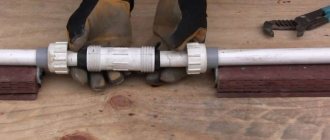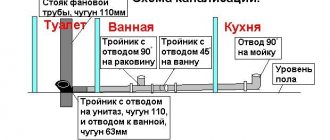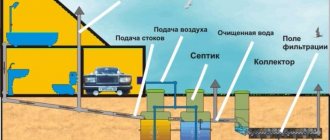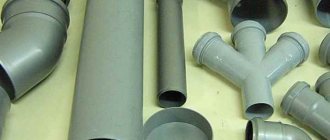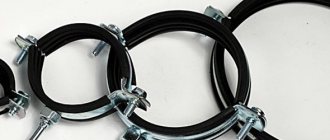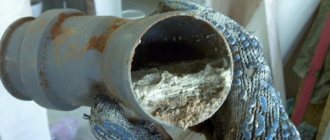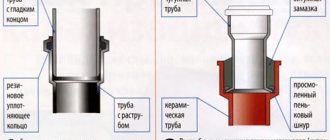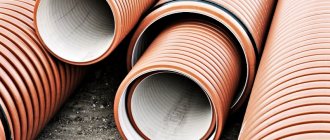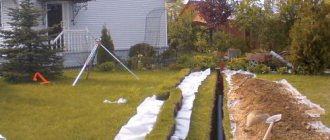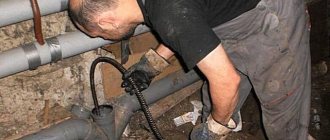The term plastic pipe is a general term that includes products made of thermoplastic. In turn, this includes pipes made of polyethylene, polyvinyl chloride, polybutylene or polypropylene, etc.
Most sewer pipelines are made of plastic pipes, so in this article we will consider the connection of just such products. After all, the reliability and durability of the entire system depends on the correct connection.
How to connect sewer pipes: focus on the material
Before thinking about how to connect sewer pipes, you need to decide on the material. Today we can talk about:
- polymer (PVC);
- cast iron;
- steel;
- asbestos-cement;
- concrete;
- ceramic;
- corrugated pipes.
The first two options are used very often, but the rest are not. We can only talk about corrugated products as components of the sewer system of large industrial facilities or external networks of private households.
Cast iron pipes are used when it comes to an external system. They are practically not afraid of corrosion, unlike steel ones, but they are too heavy for internal sewerage. Especially if you do everything yourself. Cast iron products are a great option for risers. Only a specialist can cope with fastening individual elements. Waste constantly sticks to such pipes, because their inside is covered with roughness. The risk increases significantly during the cold season. There are much fewer problems with polymer products.
Most often, PVC pipes are used for home sewerage.
General rules
If you are deciding how to connect PVC sewer pipes to each other, you need to study the installation recommendations. The rules are developed taking into account the intricacies of communications operation. They are common for pipes made of different materials:
When installing internal sewerage, products with a socket are installed so that the widening at one end is directed in the direction opposite to the water flow. This is done to avoid the formation of blockages. When laying the pipeline, ensure a slight slope. The value of this parameter depends on the size of the communications. For example, for products with a diameter of 50 mm, a slope of 0.035 is provided. The larger the size of communications, the smaller the slope. Thus, for pipes with a diameter of 100 and 150 mm, the value of this parameter will decrease, respectively, to 0.02, 0.008. To connect pipeline sections, shaped elements are used. Thanks to them, it becomes possible to change the direction of communications, tilt or turn. If pipes made of polyvinyl chloride are selected, installation with tension or bends is prohibited. When heated, this will lead to deformation of the products. If you need to make a turn, use oblique tees and half-bends. The outlet elements in these fittings are located at an angle of 30-45°, which eliminates the formation of blockages, overflow and deformation of the pipe during a volley discharge. Cleaning communications in these areas is also carried out without unnecessary difficulties. This is due to the fact that when inserted into the pipe, the sewer cable will move only in the direction of movement of the drains. In areas where various fittings are installed, clamps are used. They increase the reliability of fastening connecting elements in places where the load on communications is increased. When laying a horizontal pipeline, which is characterized by a large length, additional fastening elements are used: clamps, hangers, supports. They are installed in increments equal to 8-10 diameters of communications. If this is not done, soon after the start of operation the pipeline will sag. In this area, the likelihood of blockages will increase. When installing a vertically oriented pipeline, additional fastening elements should also be used. In this case, only clamps are used
It is important to ensure reliable fixation, so the fasteners must cover the entire circumference of the pipe. Moreover, it is necessary to install clamps in the area of the socket connection
The step is not followed in this case. If you need to connect sections of pipeline made of different materials, for example PVC and cast iron, differences in strength and ring stiffness should be taken into account. For this purpose, special fittings are used. It is prohibited to carry out installation using the chasing method. If the room has a complex configuration or it is not possible to lay a straight pipeline, you need to remember that the number of turns should be minimal, especially if a rectangular elbow is used. This will increase the likelihood of blockages and lead to destruction of the pipeline.
To avoid mistakes, you can first watch a video about the sewer pipe connection diagram.
How are PVC sewer pipes connected and what are their advantages?
The main material used to make sewer pipes is PVC. The peculiarity of this material is its softening. When exposed to high temperatures, it becomes soft, but when cooled, it returns to its previous state. Nowadays, metal pipes are practically not used, because in terms of their characteristics they are very much inferior to plastic ones. Before connecting sewer pipes, determine the main arguments in favor of the latter:
- no risk of corrosion damage. There is no need to spend money and time insulating pipes that will be laid underground;
- resistance to chemicals and aggressive environments;
- high throughput due to the smooth internal surface;
- lightness of plastic pipes;
- ease of installation, the ability to build a pipeline of any design;
- long service life. Such pipes can remain in good condition for a whole century.
The only drawback of PVC is its capacity limitations, but this can be resolved by selecting pipes of a larger diameter. It lends itself to forming elements of different configurations. A strictly defined diameter and length of each element simplifies the selection procedure for parts.
Helpful advice! Plastic pipes can also be used for external sewage systems, but care must be taken to ensure that they are not damaged in winter due to severe frosts. The salvation in such a situation is soft insulation.
An important role in the process of connecting home sewerage pipes is played by fittings, which are connectors. They help to obtain a sealed structure that does not allow unpleasant odors and moisture to pass through. You won’t have to think about replacing and repairing such elements for very long.
A variety of fittings are used to connect PVC pipes
Laying rules
Soft sewerage is installed in a similar way to traditional systems. However, in this case it does not require additional purchase of fittings for laying the route on turning sections. The product bends well, taking almost any shape.
When laying flexible sewerage, you must adhere to the following rules:
- The main line discharging domestic waste must have a slope, despite the ideal smoothness of the inner surface. Low hydraulic resistance does not require a large slope; it is enough to stick to 2 cm per 1 linear meter.
- Turning areas should be smooth. Bends less than 90 0 . This will inevitably lead to congestion.
- When laying a long straight section, the pipeline must not be allowed to sag. In this case, special holders are used.
- The connection of elastic pipe sections is carried out using a socket or a slip-on coupling. It is not recommended to use soldering at joints, as this reduces the strength of the sewer.
- The linear expansion of the flexible channel must be taken into account in order to reduce the risk of damage or deformation of the line.
- When arranging the external part of drainage from the sewer, the main characteristics of the elastic material are taken into account. This allows you to more accurately determine the maximum and minimum depth levels.
Connecting plastic sewer pipes using fittings
Several types of fittings are used to connect sewer pipes. They differ in:
- purpose (intermediate and connecting);
- structures (tees, extensions, couplings, turn signals);
- shape (straight, L-shaped, T-shaped).
If you use this particular classification when choosing materials, then it will be much easier for you to decide on specific models and explain this to the seller.
Helpful advice! When inserting the pipe into the fitting, you need to place a rubber gasket in the joint.
What to do before you start connecting sewer pipes
Sewer pipes are part of a larger system. To complete this task, you must initially complete the following steps:
- Creating a system drawing. Be sure to take into account all the objects for which you will need to provide a connection (bathroom, shower, toilet).
- Determining the connection points between pipes and the main riser. Consider the connection points - this is where the fittings are needed.
- It is definitely worth considering that sewer pipes for houses come in two diameters: 110 and 50 mm. The latter are ideal for showers, sinks and bathtubs, and washing machines.
When purchasing sewer pipes, experts do not advise taking extra material, because even if you do the work yourself, it is almost impossible to spoil them.
The types of fittings and their required quantity for installation depend on the sewerage plan
The swivel fitting connects the siphon (the hose coming from the plumbing fixture) and a metal or PVC sewer pipe. Some craftsmen do not use this connecting element, but this risks breaking the seal. It is unlikely that you want a puddle to constantly appear in your bathroom or kitchen as a result of a leaking joint.
To ensure that the sewer system lasts a long time, pay attention to the following points:
- the need to ensure a certain amount of pipe slope. This helps remove fluid as quickly as possible. Calculate the slope so that the decrease does not exceed 2-3 cm per meter of pipe;
- You need to start arranging the system with your own hands from the devices in the direction of the main riser. The flow of water will not be hampered by joints.
Characteristics
Compared to traditional products, a flexible sewer pipe has several advantages:
- Possibility of connecting pipe products without fittings.
- On a complex or turning section, there is no need to use bends and tees.
- The flexibility of the channel makes it possible to form rather long sections into coils, which greatly facilitates their transportation and storage.
- The elastic material will not burst if deformed or accidentally hit.
- The corrugated surface provides low linear expansion.
Features of the arrangement of an external sewerage system
In-house or intra-apartment sewerage requires the use of fittings. Another case is the external system. It is laid in the local area. A prerequisite is the installation of wells. Such structures allow you to clean the sewer without difficulty. Having learned how sewer pipes are connected, it becomes obvious that the external system involves the use of larger diameter pipes.
Helpful advice! Be sure to take into account the fact that when inserting a sewer pipe into an external one, it is necessary to increase the size of the latter. It is better to take a model with a “reserve” so that when the need arises to connect new plumbing, you do not have to change the entire system.
After completing the preparatory work, you can get down to business. Types of sewer pipes and connections provide two options for performing the work: detachable and permanent connections.
For external sewerage, it will be necessary to install inspection wells
How to connect sewer pipes: detachable methods
Detachable connections can be flanged or coupling. For PVC pipes, the first method is better. Do-it-yourself sealing can be achieved by using cast iron fasteners and a rubber gasket. The work consists of the following stages:
- pipe cutting. A perfectly straight cut is important. No chamfer is made;
- putting on the free flange for cutting;
- rubber gasket insert. It should protrude 10 cm from the cut;
- placing the flange on the gasket and connecting to the mating flanges;
- securing the bolts.
Coupling connections are used during repair work or during installation of non-pressure and pressure systems. For high-quality operation of the system it is necessary:
- the ends of the elements that are planned to be connected are cut at right angles;
- the coupling must be applied to the joint in such a way that its central part is at the junction of the pipes;
- a mark is made on the pipes corresponding to the position of the coupling;
- the inside of the coupling and the ends of the pipes are treated with a special lubricant;
- one of the pipes is inserted into the coupling to the limit;
- the pipes must be installed so that the axis is single;
- The coupling is pushed onto the second pipe until the mark made earlier.
This method allows you to disassemble the pipeline if necessary, but when installing it you should pay attention to the tightness of the connection.
To make the connection detachable, you can use couplings or flanges
Fasteners
The installed system is fixed with standard clamps, maintaining a distance of 1 m. The riser is fastened in increments of 1-2 m. A space of at least 5 mm is left between the wall and the pipe. The clamp should be installed directly under the socket.
The connection of a cylindrical product must be highly durable and reliable. It is important to prevent the movement of water through the structure during its operation. To reduce the internal pressure occurring in the pipe, the second clamp can be loosened slightly.
Features of permanent connection methods
Permanent connections are divided depending on the technique used:
- "into the bell." To implement it, it is necessary to connect the socket with a rubber ring and the smooth end of the pipe, having previously cleaned and degreased the surfaces. Be sure to chamfer the smooth end. Carefully lubricate the connecting surfaces with silicone grease and ensure that their longitudinal axis coincides. The smooth end must be inserted into the socket. Do not push the pipe beyond the mounting mark;
- by welding: socket and butt. When using the first method, the inner part of the socket of one pipe and the outer surface of the smooth end of the second are melted using a welding machine. When butt welding, it is necessary to melt the ends that will be connected and the joint itself. For this, moderate pressure is used;
- by gluing. You will need a special glue that lubricates the connecting ends. The choice of adhesive depends on the pipe material. Metal and plastic samples require BF-2, polymer and metal samples require epoxy, rubber and metal samples require 88N.
